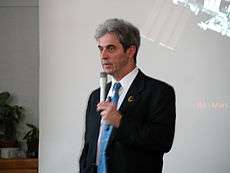Léopold Eyharts
| Léopold Eyharts | |
|---|---|
 | |
| CNES/ESA Astronaut | |
| Nationality | French |
| Status | Active |
| Born |
April 28, 1957 Biarritz, Pyrénées-Atlantiques, France |
Other occupation | Test Pilot |
| Rank | Brigadier General, French Air Force |
Time in space | 68d 21h 31m |
| Selection | 1990 CNES Group 3, 1998 ESA Group |
| Missions | Soyuz TM-27, Soyuz TM-26, STS-122, Expedition 16, STS-123 |
Mission insignia |
|
| Awards |
|
Léopold Eyharts (born April 28, 1957) is a Brigadier General in the French Air Force, an engineer and ESA astronaut.
Background
Eyharts was born April 28, 1957, in Biarritz, Basque Country, France. He graduated as an engineer from the French Air Force Academy of Salon-de-Provence in 1979.
Awards and honors
- Chevalier of the Légion d'honneur
- Chevalier of the Ordre National du Mérite
- Médaille d’Outre-Mer
- Silver National Defence Medal
- Cavalier of the Order of Courage (Russia)
- Cavalier of the Order of Friendship (Russia)
- The medal "For merits in development of space" (April 12, 2011) - for outstanding contribution to the development of international cooperation in manned space flight
Military career
He joined the French Air Force Academy of Salon-de-Provence in 1977 and was graduated as an aeronautical engineer in 1979. In 1980, he became a fighter pilot and was assigned to an operational Jaguar squadron in Istres Air Base (France). In 1985, he was assigned as a wing commander in Saint-Dizier Air Force base.
In 1988, he was graduated as a test pilot in the French test pilot school (EPNER) and was assigned to Bretigny flight test center near Paris. He then flew on different types of military and civilian aircraft including Mirage 2000, Alpha Jet, Mirage 3, Caravelle, C-160 mainly involved in radar and equipment testing.
He has logged 3500 flight hours as a fighter and test pilot in 40 different aircraft types, 21 parachute jumps including one ejection.
CNES and ESA career
In 1990, Léopold Eyharts was selected as an astronaut candidate by CNES (Centre National d’Études Spatiales) and assigned to support the Hermes spaceplane program managed by the Hermes Crew office in Toulouse.
He became one of the test pilots in charge of the CNES parabolic flights program, an experimental aircraft (Caravelle) managed by Bretigny Flight Test Center to provide a microgravity laboratory to the scientific community.
In 1992, Eyharts participated in the second European Space Agency astronaut selection. At the end of the same year, he took part in an ESA evaluation of the Russian “Buran” Space Shuttle training in Moscow, where he flew in the Tupolev 154 Buran in-flight simulator.
He also participated in two additional short-duration spaceflight training courses in Star City, Moscow — six weeks in 1991 and two weeks in 1993.
In 1994, he was in charge of parabolic flight testing of the Caravelle replacement, an Airbus A300 which become operational in 1995.
Eyharts was assigned to full spaceflight training in January 1995. He trained as a back-up crew member for the "Cassiopeia" French-Russian space mission, which took place in August 1996.
His first spaceflight came as part of the follow-on CNES scientific space mission named “Pégase.” He flew to the Mir Space Station in February 1998 aboard Soyuz TM-27. During the three-week Pégase mission, he performed various French experiments in the area of medical research, neuroscience, biology, fluid physics and technology. During his first space mission, he logged 20 days, 18 hours and 20 minutes in space.
In August 1998, Eyharts was assigned by the European Space Agency to train at NASA’s Johnson Space Center in Houston, Texas. As part of the international astronauts of the 1998 class, he attended NASA Astronaut Candidate Training which included orientation briefings and tours, numerous scientific and technical briefings, intensive instruction in Shuttle and International Space Station systems, physiological training and ground school to prepare for T-38 flight training, as well as learning water and wilderness survival techniques. He served in technical assignments until assigned to a space flight.

He launched on board Space Shuttle mission STS-122 to the International Space Station on February 7, 2008, where he joined Expedition 16. He participated in the installation and configuration of the Columbus European laboratory module. He returned to Earth aboard mission STS-123 in March 2008.[1]
References
![]() This article incorporates public domain material from websites or documents of the National Aeronautics and Space Administration.
This article incorporates public domain material from websites or documents of the National Aeronautics and Space Administration.
External links
- ESA profile page
- Spacefacts biography of Léopold Eyharts
- ESA astronaut Léopold Eyharts assigned to European Columbus laboratory mission to the ISS
- Léopold Eyharts, the man who will bring Columbus to life

